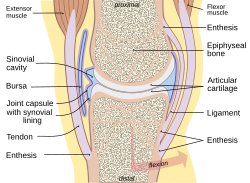Ligament
| Ligament | |
|---|---|

Diagram of the right knee.
|
|

Typical joint
|
|
| Details | |
| Identifiers | |
| Latin | Ligamentum (Plural: Ligamenta) |
| TA | A03.0.00.034 |
| FMA | 21496, 30319 70773, 21496, 30319 |
|
Anatomical terminology
[]
|
|
In anatomy, a ligament is the fibrous connective tissue that connects bones to other bones and is also known as articular ligament, articular larua,fibrous ligament, or true ligament.
Ligament can also refer to:
The study of ligaments is known as (from Greek δεσμός, desmos, "bond"; and -λογία, -logia).
Ligaments are similar to tendons and fasciae as they are all made of connective tissue. The differences in them are in the connections that they make: ligaments connect one bone to another bone, tendons connect muscle to bone, and fasciae connect muscles to other muscles. These are all found in the skeletal system of the human body. Ligaments cannot usually be regenerated naturally; however, there are periodontal ligament stem cells located near the periodontal ligament which are involved in the adult regeneration of periodontal ligament.
"Ligament" most commonly refers to a band of dense regular connective tissue bundles made of collagenous fibers, with bundles protected by dense irregular connective tissue sheaths. Ligaments connect bones to other bones to form joints, while tendons connect bone to muscle. Some ligaments limit the mobility of articulations, or prevent certain movements altogether.
Capsular ligaments are part of the articular capsule that surrounds synovial joints. They act as mechanical reinforcements. Extra-capsular ligaments join together in harmony with the other ligaments and provide joint stability. Intra-capsular ligaments, which are much less common, also provide stability but permit a far larger range of motion. Cruciate ligaments are paired ligaments in the form of a cross.
...
Wikipedia
